![How to Create a Budget for Commercial Real Estate [With Template]](https://img.shgstatic.com/clutch-static-prod/image/resize/715x400/s3fs-public/article/d084e92eb854adb65c33b5a29b439cc4.png)
![How to Create a Budget for Commercial Real Estate [With Template]](https://img.shgstatic.com/clutch-static-prod/image/resize/715x400/s3fs-public/article/d084e92eb854adb65c33b5a29b439cc4.png)
Updated January 2, 2025
Employees appreciate when their office is near food and drink options, but what they want most is for their office to be near home. Employees want a short commute, whether they walk, bike, drive, or take public transportation to work. Businesses should cater to employees’ commutes and locate their offices near ample parking or public transportation options.
Most employees in the U.S. whose companies have moved office spaces say the office relocation had a positive effect on them and their company.
What factors contributed to this positive sentiment? What role does office location play in shaping employees’ happiness and productivity at work?
Looking for a Real Estate agency?
Compare our list of top Real Estate companies near you
Clutch surveyed 503 full-time employees in the U.S. to discover the real question on everyone’s mind: Should an office be near employees’ homes, or is it better to be near food, drink, and shopping options?
We found that employees care more about working close to home than any other office location perks. Businesses, however, focus more on proximity to restaurants and coffee shops without much regard to employees’ commutes.
This article examines the pros and cons of 5 location factors that are crucial to fostering a comfortable and productive workplace:
Businesses thinking of moving offices can use this survey to learn what type of location their employees prefer and how to keep employees happy by catering to their preferences.
Employees appreciate working near places to eat and drink coffee — yet most bring lunch to work, no matter if restaurants and cafés are nearby.
Seventy percent (70%) of offices are near restaurants, and 62% are near coffee shops.
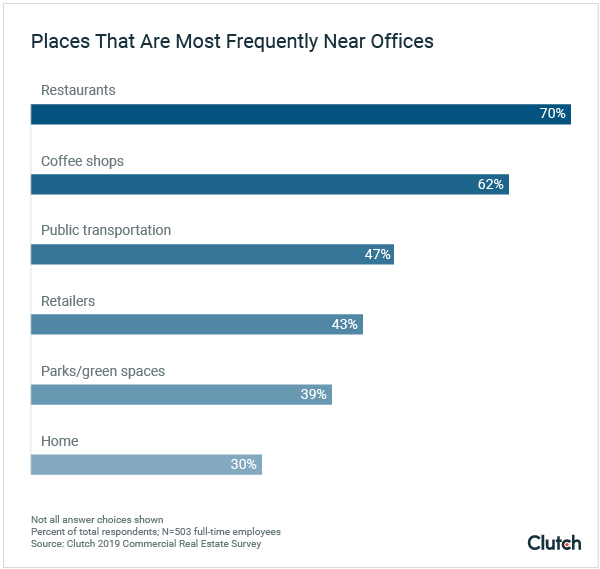
Fewer than half of offices, however, are close to:
A company’s location can be an asset to its recruitment and employee retention.
“With the low unemployment rate resulting in labor shortage, employers are having to compete for top talent,” said Russ Moroz, first vice president of investments at commercial real estate investment firm Marcus & Millichap. “Location often makes the difference between employees choosing to work for one company over another.”
Businesses with an ideal office location will have an easier time meeting employee wants and needs, especially in a job market where recruits can be picky about where they work.
When businesses are near restaurants and coffee shops, they provide options for their employees to get lunch easily or have a quick coffee break.
“Companies don’t want their employees getting in the car and driving an hour to lunch,” said Tom Fuge, regional senior vice president at Truss, an online marketplace for small and medium-sized businesses to find, tour, and lease office spaces.
“Companies don’t want their employees getting in the car and driving an hour to lunch."
Employees with food options near their office can buy lunch quickly without wasting much time out of the office. This means more working hours can be spent actually in the office.
Employees want the ability to leave their office for a quick lunch or coffee break. Businesses want to offer this ability without employees wasting too much time.
Only a small percentage of employees regularly go out to buy lunch while at work, despite most businesses being near food and drink options.
Just 22% of employees buy lunch at work at least 3 times per week.
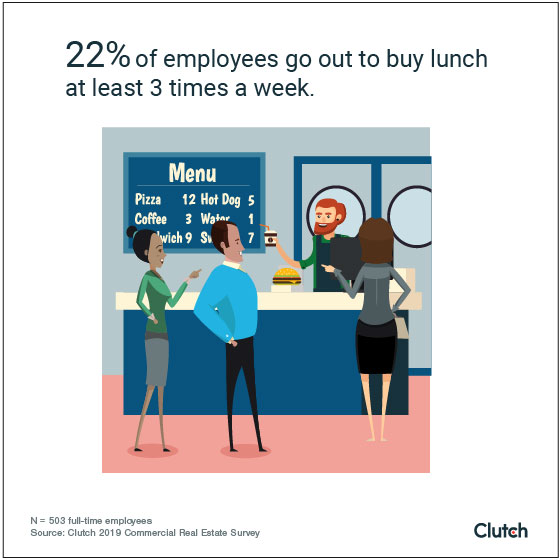
Nearly half of employees (47%), on the other hand, bring their lunch to work 3 times per week or more.
Even though most employees prefer to bring their lunch to work, they still appreciate being near food and drink options.
“Employees really value choice in how and where they spend their time,” said David Fields, executive vice president of CBRE, the largest commercial real estate company in the world. “Having the option to eat lunch elsewhere or spend time outside the office and experience surrounding amenities can be a valuable benefit to employees.”
“Having the option to eat lunch elsewhere or spend time outside the office and experience surrounding amenities can be a valuable benefit to employees.”
Employees want restaurants and coffee shops near their office, even if they don’t normally take advantage of their proximity.
Isaiah Goodman, chief financial advocate of Becoming Financial, a Minneapolis-based company that helps people develop financial skills, brings lunch to work almost every day, but he also likes having food options near him.
“There is always an occasional day where I forget lunch at home,” Goodman said. “On these days, it is a huge time-saver … to be able to run to nearby shops or restaurants to grab a quick lunch.”
Offices that are near food and drink options offer convenience for employees.
People want to work near where they live, a preference that most companies don’t meet.
Nearly half of employees (49%) say being near their home is the top location preference for an office. Just 30% of employees’ offices, however, are actually near their home, showing a disconnect between employee desires and company offerings.
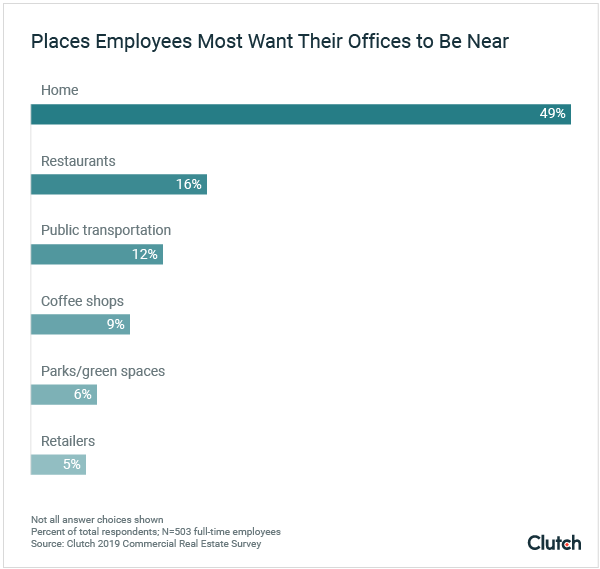
Less important office location factors include being near restaurants (16%) or public transportation (12%).
Finding a new office location that is close to employees’ homes is difficult for businesses: 28% of employees whose businesses moved offices said a further commute was a challenge of office relocation.
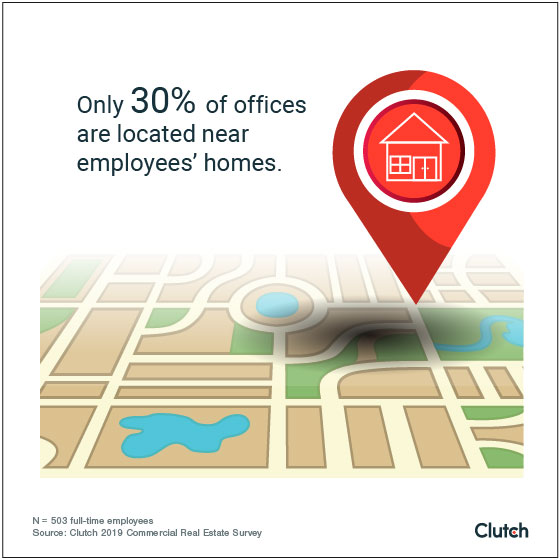
Some businesses, however, are listening to employee needs and relocating their offices closer to workers’ homes, even if it means sacrificing an ideal location.
For example, Chris Baumann, team leader of the Loans and Investments divisions for real estate lending and investment firm Socotra Capital worked with a client that relocated from downtown Sacramento, Calif., to an “outskirt city” to be closer to employees’ homes.
“I questioned why they left a high-visibility location to move to a remote business park,” Baumann said. “They explained that the biggest factor was to improve their employee’s quality of life with their family relations. ... The convenience and proximity allow for more flexible work times and longer workdays.”
"The convenience and proximity allow for more flexible work times and longer workdays.”
Companies may have to sacrifice being near other amenities such as restaurants, coffee shops, and retailers to be near employees’ homes. This sacrifice, however, can make employees happier with their work-life balance
People with short, easy commutes are healthier and more successful at work. In fact, employees with shorter commutes are more likely to both perform better at work and miss fewer days of work.
People who travel 45 minutes or more each way to work, on the other hand, tend to take more sick days.
We found that nearly two-thirds of employees (63%) have a commute of 30 minutes or less, which is in line with the average commute time in the U.S.: 26.1 minutes.
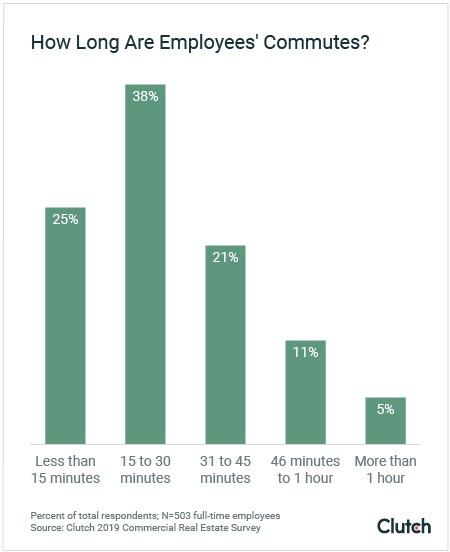
Still, spending about 26 to 30 minutes commuting to work is about 9 days per year each American spends on commuting alone.
About one-fourth of lucky employees (25%) have a commute of less than 15 minutes, and just 5% of unlucky employees have a commute of more than an hour.
Companies with offices far from employees’ homes may have a challenging time recruiting new workers. Businesses should research where their target employees live and choose an office space either near there or in a place that’s convenient to commute to.
“Commuting costs employees time and money,” said Ralph Benzakein, senior vice president of Cresa, a commercial real estate occupier advisory firm. “In times of low unemployment, employers are competing for employees on many levels. A 10-minute commute is going to look a lot more attractive to a prospective employee than an hour.”
"A 10-minute commute is going to look a lot more attractive to a prospective employee than an hour.”
A longer commute may be easier on certain forms of transportation than others. For example, people who drive 40 minutes to work must focus only on their commute and the traffic around them. People who take a metro 40 minutes to work, however, can focus on tasks beyond simply commuting, such as reading or reviewing notes. The commuter on the metro may not feel the 40 minutes are wasted.
An employee deciding between two jobs may choose the closer office or at least one with an easier commute. Some employees even leave jobs because of difficult commutes.
Speaker and coach Michael Arnold, for example, switched jobs in 2018 to go from a 50-minute commute to a 15-minute one. He finds his shorter commute gives him more free time.
“Before, I would work late, sit in traffic, get home, and eat,” Arnold. “Now, I have the freedom to go to a workout session at 6 p.m., which I could never do before because I’d be in traffic.”
Arnold can now exercise and do other activities before and after work, rather than spending time in his car for almost an hour each way.
Arnold’s former commute was an unnecessary burden for him. He finds his new commute wastes less personal time.
“You get paid for going to work,” Arnold said. “You don’t get paid for your commute. That’s your time, and you need your time.”
“You don’t get paid for your commute. That’s your time, and you need your time.”
Overall, a short commute makes people happier with their lives.
“People want to be able to spend their time how they want to spend their time, not necessarily on a long commute,” Fuge said. “People want to be able to get up and spend time with their family or go to the gym and still have enough time to get to the office at a reasonable hour.”
People with shorter commutes have more free time, save money, are healthier, and are happier both on the job and in their personal lives.
Businesses with offices near metro, train, or bus stops can recruit a range of employees, rather than limit themselves to only employees who can drive or walk to work.
Around half of offices (47%) are near public transportation. Naturally, more offices in urban locations (55%) are near public transportation: The places with the highest percentage of workers who commute by public transportation are all major cities – New York (31%), San Francisco (16.5%), Washington, D.C. (14%), Boston (12.9%), and Chicago (11.8%).
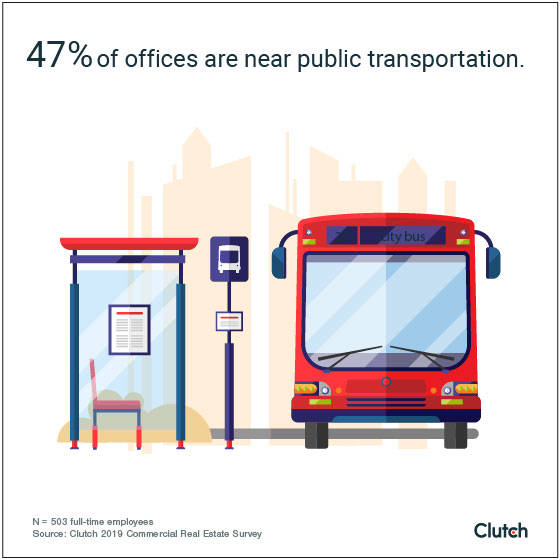
Businesses near a public transit station can attract employees from beyond their immediate area.
“Proximity to a mass transit hub is a major advantage for an office location,” said John Boyd, principal of Boyd Company, which provides independent real estate location council to corporations. “Being close to mass transit allows HR departments to recruit the best and brightest from the entire labor market.”
Companies may have an easier time recruiting a variety of employees if they are near public transportation.
For example, in the San Francisco Bay Area, about 17% of employees take the Bay Area Rapid Transit (BART) light rail to work. Employees who don’t have cars are limited to offices near a BART station.
“In the area, where some of the residents don’t even own a vehicle, proximity to the region’s light rail system is extremely important,” Moroz said.
Businesses can attract a more diverse and qualified candidate pool by being near public transportation.
Americans spend an average of 17 hours per year searching for parking, which could lead to stress and burnout – even before employees get to work.
Parking is also expensive. The average motorist wastes $345 in time, fuel, and emissions every year just from searching for a parking space. That number is larger in bigger cities, such as New York, where people spend 107 hours per year and waste $2,243 trying to find parking.
About 70% of workers drive alone to work — more than employees who walk, bike, or take public transportation to work combined.

Because most employees bring their cars to work, they expect to park at or near their office.
Businesses that don’t offer parking create undue frustration when they force employees to find an open parking space every day.
“The last thing you want to do is to spend time and be late [to work] all because you were trying to find parking,” said John Rampton, founder and CEO of scheduling software Calendar. “That is an unnecessary waste of time that can be avoided by offering parking.”
“The last thing you want to do is to spend time and be late [to work] all because you were trying to find parking.”
Offices with included parking can lead to higher job satisfaction and happier employees.
“When companies choose either to provide and/or pay for parking, employees often view these as added benefits or amenities that will improve their quality of life,” Fields said.
Employees who don’t have to search for parking every day before work can get to the office relaxed, not stressed.
Many employees are frustrated by spending time and money on parking every day, such as Goodman, who lives in Minneapolis. Many of his coworkers take the bus to work, but he drives because he has to drop his child off at daycare.
“I really wish my company offered parking,” Goodman said. “It’s a significant expense to employees to park in our large downtown city area.”
Offices that provide parking can make the commutes of employees who drive to work more manageable, and they could make employees happier and more productive at work.
Though the type of space and amenities are important considerations when choosing an office, location is important, too.
Businesses should find an office that is near restaurants and cafés to make it convenient for employees who choose to eat lunch or take coffee breaks outside the office.
The most important office location factor, however, is proximity to employees’ homes. Employees don’t want to spend a lot of time going to and from work every day, so businesses should ease their commutes.
Businesses with employees who mainly drive to work must offer ample parking options, and businesses with employees who take public transportation to work must be located near a bus, train, or other public transit stop.
When companies offer an easy commutes for employees, they make workers healthier, happier, and more productive.
Clutch surveyed 503 full-time employees across the U.S.
Half of the respondents work in an urban area (50%); 38% work in a suburban area; and 11% work in a rural area.
Sixty-one percent (61%) of respondents are female; 39% are male.
Respondents are from the South (37%), Midwest (22%), West (21%), and Northeast (20%).
Respondents are 18-24 (9%); 25-34 (35%); 35-44 (33%); 45-54 (16%); 55-64 (7%); and 65 and older (1%).
![How to Create a Budget for Commercial Real Estate [With Template]](https://img.shgstatic.com/clutch-static-prod/image/resize/715x400/s3fs-public/article/d084e92eb854adb65c33b5a29b439cc4.png)
![How to Budget for A Business Relocation [With Template]](https://img.shgstatic.com/clutch-static-prod/image/resize/715x400/s3fs-public/article/da44ab3f488dff79138f31d3d3df081c.png)
